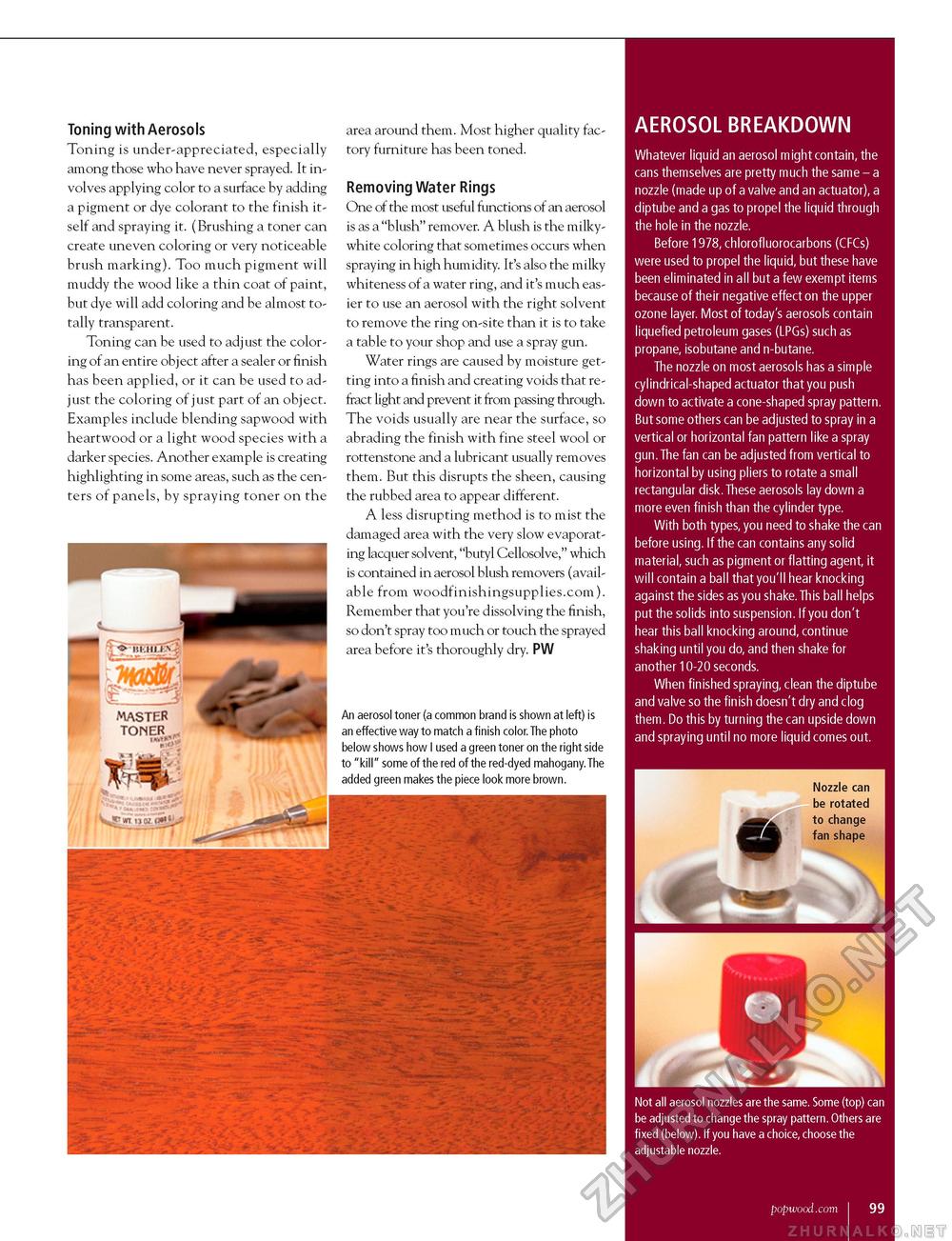Popular Woodworking 2003-10 № 136, страница 99
AEROSOL BREAKDOWN Whatever liquid an aerosol might contain, the cans themselves are pretty much the same - a nozzle (made up of a valve and an actuator), a diptube and a gas to propel the liquid through the hole in the nozzle. Before 1978, chlorofluorocarbons (CFCs) were used to propel the liquid, but these have been eliminated in all but a few exempt items because of their negative effect on the upper ozone layer. Most of today's aerosols contain liquefied petroleum gases (LPGs) such as propane, isobutane and n-butane. The nozzle on most aerosols has a simple cylindrical-shaped actuator that you push down to activate a cone-shaped spray pattern. But some others can be adjusted to spray in a vertical or horizontal fan pattern like a spray gun.The fan can be adjusted from vertical to horizontal by using pliers to rotate a small rectangular disk.These aerosols lay down a more even finish than the cylinder type. With both types, you need to shake the can before using. If the can contains any solid material, such as pigment or flatting agent, it will contain a ball that you'll hear knocking against the sides as you shake.This ball helps put the solids into suspension. If you don't hear this ball knocking around, continue shaking until you do, and then shake for another 10-20 seconds. When finished spraying, clean the diptube and valve so the finish doesn't dry and clog them. Do this by turning the can upside down and spraying until no more liquid comes out. Toning with Aerosols Toning is under-appreciated, especially among those who have never sprayed. It involves applying color to a surface by adding a pigment or dye colorant to the finish itself and spraying it. (Brushing a toner can create uneven coloring or very noticeable brush marking). Too much pigment will muddy the wood like a thin coat of paint, but dye will add coloring and be almost totally transparent. Toning can be used to adjust the coloring of an entire object after a sealer or finish has been applied, or it can be used to adjust the coloring of just part of an object. Examples include blending sapwood with heartwood or a light wood species with a darker species. Another example is creating highlighting in some areas, such as the centers of panels, by spraying toner on the area around them. Most higher quality factory furniture has been toned. Removing Water Rings One of the most useful functions of an aerosol is as a "blush" remover. A blush is the milky-white coloring that sometimes occurs when spraying in high humidity. It's also the milky whiteness of a water ring, and it's much easier to use an aerosol with the right solvent to remove the ring on-site than it is to take a table to your shop and use a spray gun. Water rings are caused by moisture getting into a finish and creating voids that refract light and prevent it from passing through. The voids usually are near the surface, so abrading the finish with fine steel wool or rottenstone and a lubricant usually removes them. But this disrupts the sheen, causing the rubbed area to appear different. A less disrupting method is to mist the damaged area with the very slow evaporating lacquer solvent, "butyl Cellosolve," which is contained in aerosol blush removers (available from woodfinishingsupplies.com). Remember that you're dissolving the finish, so don't spray too much or touch the sprayed area before it's thoroughly dry. PW Not all aerosol nozzles are the same. Some (top) can be adjusted to change the spray pattern. Others are fixed (below). If you have a choice, choose the adjustable nozzle. popwood.com I 99 |








